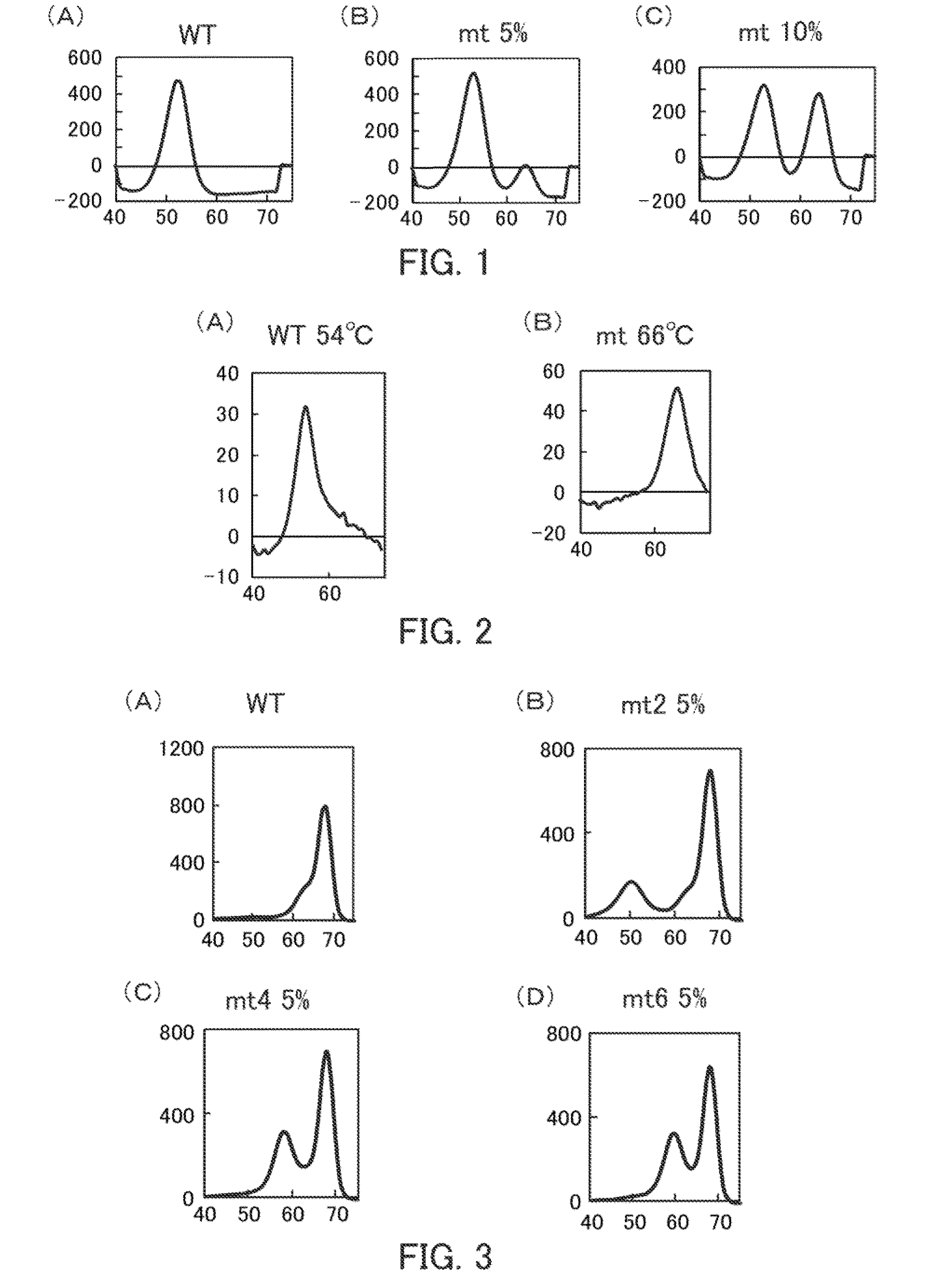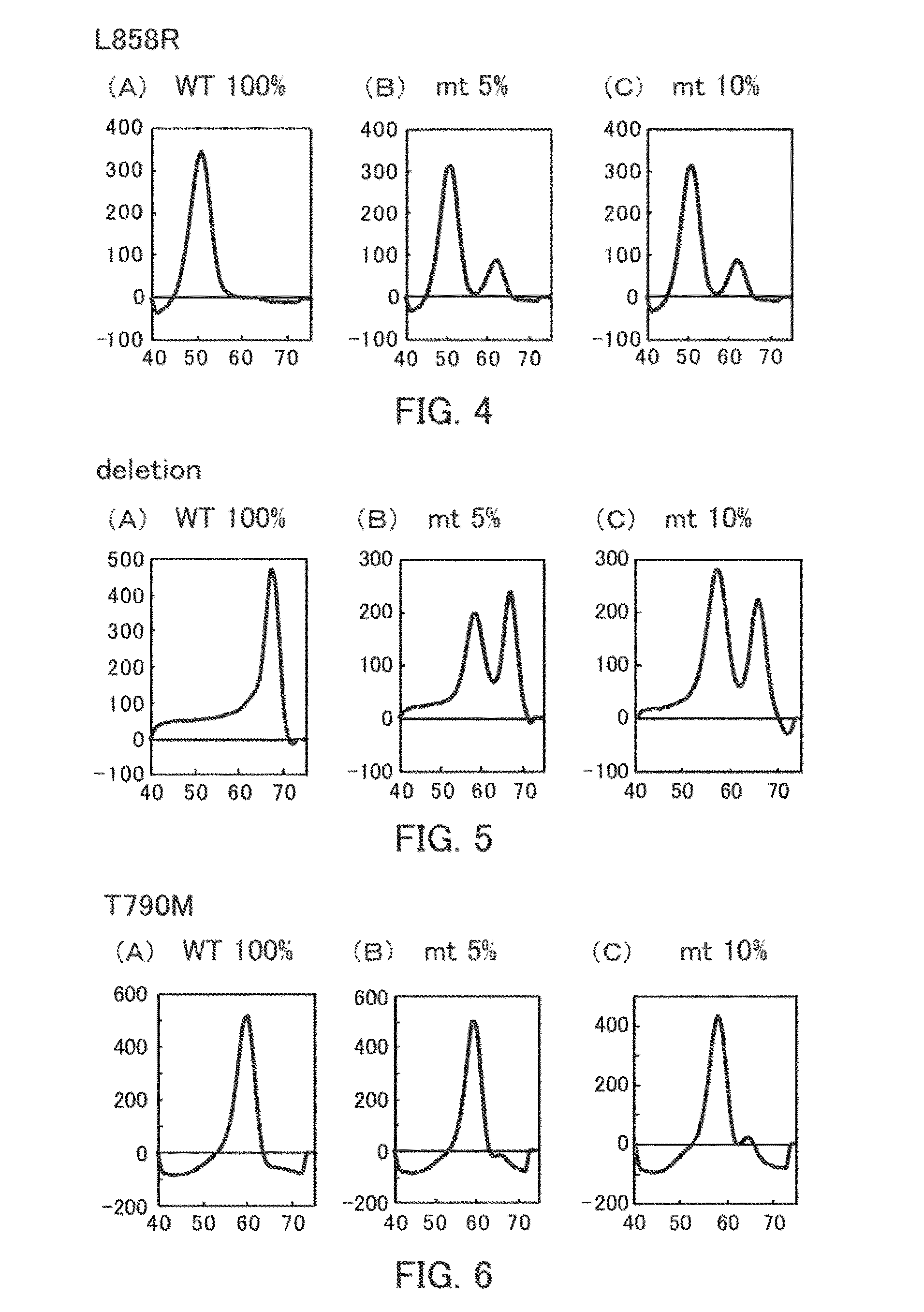Probe for Detection of Polymorphism in EGFR Gene, Amplification Primer, and Use Thereof
a polymorphism and probe technology, applied in the field of probes for detection of polymorphisms in egfr genes, can solve the problems of high labor intensity, contamination risk of separate subsequent reactions, and difficult to detect polymorphisms, and achieve simple and highly reliable determination of polymorphisms, high reliability, and high reliability
- Summary
- Abstract
- Description
- Claims
- Application Information
AI Technical Summary
Benefits of technology
Problems solved by technology
Method used
Image
Examples
example 1
[0285]Tm analysis was performed in the common presence of a wild-type plasmid and a mutant-type plasmid in order to detect an EGFR858 polymorphism in an EGFR gene.
[0286]The wild-type plasmid and a mutant-type plasmid are prepared as an EGFR858 wild-type plasmid (L858WT) and as an EGFR858 mutant-type plasmid (L858R). The EGFR858 wild-type plasmid (L858WY) includes a partial sequence of the EGFR gene by insertion of the oligonucleotides from position 112 to position 411 of SEQ ID NO: 1, and in which the nucleotide (k) at position 261 of SEQ ID NO: 1 is thymine (t). The EGFR858 mutant-type plasmid (L858R) includes a partial sequence of the EGFR gene by insertion of the oligonucleotides from position 112 to position 411 of SEQ ID NO: 1, and in which the nucleotide (k) at position 261 of SEQ ID NO: 1 is guanine (g). These plasmids are mixed in a predetermined ratio as shown below to thereby prepare three types of samples. These samples include 250 plasmid copies per μL.
TABLE 3Mixing Rati...
example 2
[0292]In the present example, Tm analysis was respectively executed in relation to wild-type artificial nucleic acid and mutant-type artificial nucleic acid to thereby detect the EGFR 858 polymorphism in the EGFR gene.
[0293]EGFR858 wild-type artificial nucleic acid (EGFR-L858R(WT)-F) and EGFR858 mutant-type artificial nucleic acid (EGFR-L858R(MT)-F) that is homologous to positions 241 to 290 SEQ ID NO: 1 as illustrated in the sequence below were prepared. In the following two sequences, the underlined portion corresponds to the nucleotide at position 261 SEQ ID NO: 1. The respective artificial nucleic acids were adjusted to 5 pmol / L and were used as test samples.
EGFR-L858R(WT)-F(SEQ ID NO: 32)caagatcacagattttgggctggccaaactgctgggtgcggaagagaaagEGFR-L858R(MT)-F(SEQ ID NO: 33)caagatcacagattttgggcgggccaaactgctgggtgcggaagagaaag
[0294]Tm analysis was performed in relation to 25 μL of the reaction solution as illustrated in Table 5 using a fully automatic SNPs detection apparatus (product na...
example 3
[0298]In the present example, Tm analysis was performed in relation to wild-type oligonucleotides and mutant-type oligonucleotides to thereby detect the EGFR gene exon19 polymorphism. The detection wavelength of BODIPY FL was 520-555 nm, and the detection wavelength of TAMRA was 585-700 nm.
(1) Oligonucleotide
[0299]The wild-type and mutant-type oligonucleotides were prepared using the oligonucleotides 1-8 in Table 6. These oligonucleotides are sequences that are complementary to the sense strand of the EGFR gene. The oligonucleotide 1 is the wild-type oligonucleotide, and is complementary to the partial sequence of the sense strand including the exon 19 polymorphism 1. The oligonucleotides 2-18 are the mutant-type oligonucleotides, and are complementary to the partial sequence of the sense strand including the exon 19 polymorphisms 2-18. Table 6 shows the corresponding domain in the nucleotide sequence of SEQ ID NO: 2 for each oligonucleotide. The range of the nucleotide sequence con...
PUM
| Property | Measurement | Unit |
|---|---|---|
| Tm | aaaaa | aaaaa |
| Tm | aaaaa | aaaaa |
| Tm | aaaaa | aaaaa |
Abstract
Description
Claims
Application Information
 Login to View More
Login to View More - Generate Ideas
- Intellectual Property
- Life Sciences
- Materials
- Tech Scout
- Unparalleled Data Quality
- Higher Quality Content
- 60% Fewer Hallucinations
Browse by: Latest US Patents, China's latest patents, Technical Efficacy Thesaurus, Application Domain, Technology Topic, Popular Technical Reports.
© 2025 PatSnap. All rights reserved.Legal|Privacy policy|Modern Slavery Act Transparency Statement|Sitemap|About US| Contact US: help@patsnap.com



